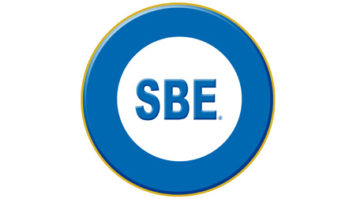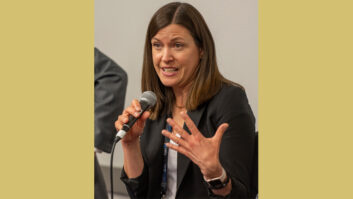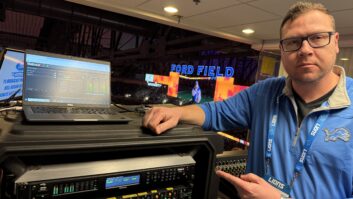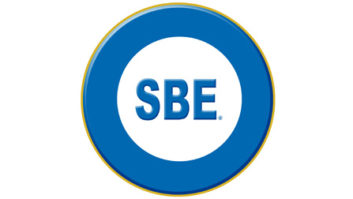
Steve Lampen is familiar to most of us engineers as the face of Belden Inc. Hardly a major industry show or conference goes by without his presence and up-to-date engineering information about the wire and cable products we all use.
His full title at Belden is multimedia technology manager and product line manager for entertainment products. As part of the first half of that lengthy title, Lampen meets with broadcast engineers all over the world. The second half involves coming up with new technology products. Lampen, who also is a contributor to Radio World, was named SBE Educator of the Year recently.
As someone who spends much of his time talking to broadcast engineers, Lampen is qualified to talk about technology trends that affect the radio broadcast industry. We connected via e-mail recently to talk about the industry and where things could be heading.
What is your impression about the state of the radio industry right now?
I think radio is going through some major changes. First, there was the “Internet broadcaster” who has siphoned off a significant percentage of their non-mobile audience. The only reason that the Internet has not claimed a larger share is that there is no way to count, or even estimate, listenership. I have read that there are 55,000 Internet broadcasters, although I have no idea how they would qualify, much less count, these entities. Besides, it only takes a $99 CD player and a simple adaptor and you’re an “Internet broadcaster.”
The second concern is HD-AM, which still seems to be wandering around in limbo for many broadcasters. HD-FM is doing much better, although I would love to know what the long-term goal and long-range plans are for this format.

Steve Lampen
The third, and most serious, challenge will be “cloud” broadcasting, which nobody has mentioned (that I have seen). When you can download anything, anytime, in any order and pay a few cents, or nothing? I simply can’t see how existing radio broadcast can compete. What can they offer that you can’t find cheaper, at better quality, and with greater choices?
Apple is experimenting with a cloud service to help consumers access their media content more easily. When this includes constant bit-stream data (i.e., radio or television) the whole thing will grind to a halt, starved by lack of wireless bandwidth. Consumers like convenience, but they also dislike a progress bar.
With this will come targeted advertising, the Holy Grail of market penetration. You’re sitting in your local coffee house when your iPad says, “Hey! You like Mexican food” — which they have learned from their capture of your search data — “there’s a new Mexican place right around the corner. And they feature the chorizo burritos you love!” And how much is that worth to an advertiser?
Do you see regional differences in how well broadcasters are doing?
Sorry, I am not tuned in to this kind of data. My big-picture view says broadcasters are acting the same as most other businesses. Those that were wise with their money at the start of the recession are now reaping the rewards. Those that ignored the warnings are still suffering and some have changed hands or, even worse, just closed their doors.
Wire and cable are essential infrastructure to new buildouts of studios and consolidations. Do you see a pickup in that business?
On the TV side, where they spent a wad in the digital upgrade, things are slowly coming back to normal. On the radio side, that has even more market pressure, but wasn’t pushed as hard into new technology, these stations recovered faster, but I think that masks the fact that there are some big winners and some big losers.
One of the losers is the small-market independent station, which I think has lost ground in the recession that may not be recoverable. Many of these have been gobbled up by the giant station groups, losing their local character and ushering in a very restricted range of common formats that the Internet would be glad to mimic.
It has been more than a decade since the move to convert audio signals from analog to AES serial digital. Is AES serial digital itself now falling prey to the march toward multi-purpose standardized wiring systems based on Cat-5/6 and the RJ-45?
I am constantly amazed by our sales figures of analog audio cable. Most of the audio, even in networks and station groups, is still analog. Quality is excellent. It’s easy to install. And the price can’t be beat. But whole villages in India went from nothing to cell phones. I think a lot of radio broadcasters will be doing the same thing. And the change will be to “AVB.”
AVB is a new Ethernet standard, P802.1BA AVB, for “audio-video bridging.” This is not new devices aimed at audio and video, but a complete rewrite of the Ethernet standard that will include bells and whistles such as low latency and aligned bit-streams (among many features) aimed at expanding the Ethernet market. The Cobranets, Axias, Ethersounds and other proprietary Ethernet systems will now have to contend with a common interoperability standard. This signals a new day for the infrastructure of broadcast facilities.
If you were asking me how would broadcast engineers prepare for this, I would say, “Take a networking class” or even better, “Learn how to program a managed Ethernet switch.” And if you don’t know what that means, and don’t want to learn, I truly hope your 401(k) is in order.
Tell me a bit more about your role at Belden.
My role as multimedia technology manager is to travel around the world and talk to broadcast engineers. Lest you think the USA has been singled out, the digital revolution is happening everywhere. And the funny thing is broadcast engineers in Santiago, Chile or Helsinki, Finland all think they’re missing the boat and need to catch up … when many of them are ahead of the pack. As product line manager, my job is to think up our new products.
As you can tell, one of my key challenges is to link together our networking division with our audio-video division, which is going to happen with or without us. Belden now owns two manufacturers of Ethernet switches (Hirschmann in Germany and Garretcom in the United States), and I am sure they are wondering why this broadcast guy (me) is bugging them on a regular basis. But now you understand! Along the way, there will be many products with features of both traditional audio and video and with traditional Ethernet, and slowly these product lines will merge.
Comment on this or any story in RW Engineering Extra. Email [email protected].







